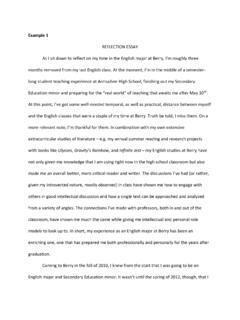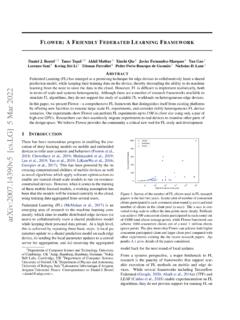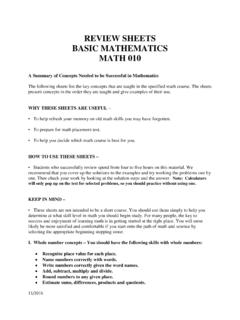Transcription of Process Mapping: Tools and Techniques - Berry College
1 Process Mapping: Tools and TechniquesProcess Mapping: Tools and TechniquesWhat is Process mapping? Process mapping is the task of defining what exactly a business does, who is responsible, and what is the standard by which the success of a business Process can be judged. Mapping: Tools and TechniquesWhy is Process mapping important? Onboarding new a set of documented processes for new employees to follow can shorten training time, put less strain on other staff members, and help to ensure consistency and continuity of Mapping: Tools and TechniquesWhy is Process mapping important? Communicating processes to times it is necessary to be able to show a Process to others. The visual structure of a business Process map makes it easier to understand the Process without having to read (and try to comprehend) a long, narrative Mapping: Tools and TechniquesWhy is Process mapping important? Process improvement and a Process is documented and understood, it can be analyzed to improve Mapping: Tools and TechniquesSteps Involved in Business Process Mapping Identify the Process you want to document Gather information from Process participants via interviews or observations Identify the start and end points of your Process Break the Process into distinct tasks and decision points Mapping: Tools and TechniquesBasic Components of Business Process Mapping overall workflow from a starting point to its successful completion.
2 Tasks or performed by a person or a system. is indicated on the Process map by connecting lines and arrows. are triggers that cause a Process to begin, end, or may redirect a Process to a different path. that can change the path of the Process depending on conditions or events. naming the people or systems that perform the tasks or Mapping: Tools and TechniquesPrimary Objective of Process Mapping: Visually display what happens in a Down Flow ChartSwim Lane Flow ChartSimple Process FlowchartProcess Mapping: Tools and TechniquesGraphic symbols represent the nature and the flow of the steps in a Process : Document or reportActivityInput or outputBeginning or end Direction of FlowDecisionFile or storeManualInput Process Mapping: Tools and TechniquesEnterprise Process Map for making a deposit using graphic symbols: Process Mapping: Tools and TechniquesTop Down mapping generally does not use graphic symbols and is defined by starting and stopping points, milestones and the how to of the Process .
3 Procedure: 1st: Define your starting and stopping points. 2nd: Define the milestones (the what s) 3rd: Complete your drill down (the how s) Process Mapping: Tools and TechniquesExample of a Top Down Process Mapping: Tools and TechniquesTop Down Mapping does not: Show who does what when. Does not show activity processing time. Does not answer what if s. Process Mapping: Tools and TechniquesExample of Swim Lane Process Map-Enterprise Gating ProcessProcess Mapping: Tools and TechniquesA swim lane Process mapsometimes called a cross-functional diagram, is a Process flowchart that provides more information on who does what than a top down. It can also be expanded to show times when tasks are done and how long they take. Process Mapping: Tools and TechniquesIn a Swim Lane processes are grouped by placing them in lanes. can be either horizontal or vertical, depending on the Process flow diagram. lane is allocated to an actor or group of steps which are performed by one an actor or group are drawn in that person's lane.
4 Provide directions for hand off from lane to lane. Process Mapping: Tools and TechniquesExample of Swim Lane Map, Dr. John Grout, Campbell School of BusinessProcess Mapping: Tools and TechniquesSwim lane maps take more time to develop. Help identify time traps which processes take the longest as well as capacity constraints, or which resources get bogged down because of work. Ideally, after identifying the current Process , teams should try to map out a better Process , based on the information provided in the diagram. Process Mapping: Tools and Techniques A simple Process flowchart is probably the most versatile of the commonly used flowchart types and can be applied to virtually anything. A simple Process flowchart shows inputs, activities, decisions and outputs of a Process , partial Process , or even a single Process step. These are shown in a successive manner without denoting all the different functions within the concerned Mapping: Tools and TechniquesExample of a Simple Process Flowchart: Cashing a CheckClick here to complete your training.








